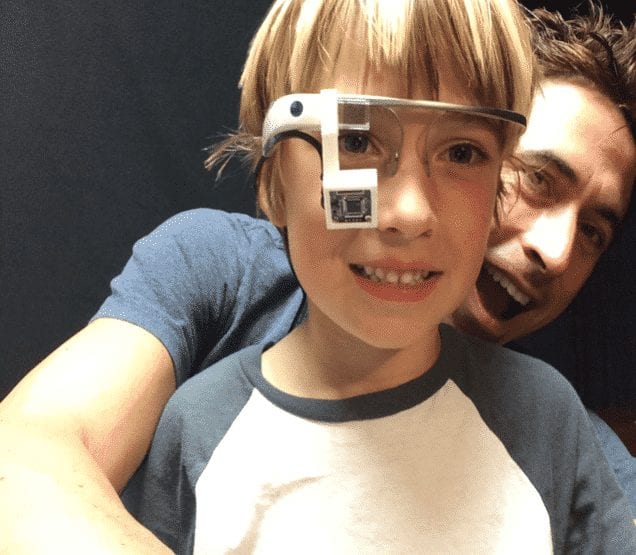
Google Glass may help kids with autism read facial expressions
نظارة جوجل قد تساعد الأطفال المصابين بالتوحد على قراءة تعابير الوجوه
(Reuters Health) – Children with autism may be better able to understand facial expressions and improve their social skills by using a Google Glass headset and smartphone app, a small pilot study suggests.
The prototype tool, called Superpower Glass, uses games to help children recognize faces and emotions while interacting with family and friends.
“Waiting lists for behavioral therapy are sometimes 18 months long, and families often have to navigate the complexity of the healthcare system on their own to find help,” said senior study author Dennis Wall of Stanford University in California.
About 1 in 68 children in the U.S. have autism, according to the Centers for Disease Control and Prevention.
Children with autism spectrum disorder struggle to recognize facial expressions, make eye contact and engage in social interactions, but many can improve dramatically if social skills are taught from an early age, Wall’s team notes in NPJ Digital Medicine.
“The sooner we can help children after diagnosis, the better off they’ll be,” Wall said in a phone interview. “It’s heartbreaking to think of kids missing opportunities while waiting for therapy.”
The researchers developed Superpower Glass, a machine-learning-assisted software system that runs on the Google Glass headset and an Android smartphone. The software recognizes eight emotions: happiness, sadness, anger, distrust, surprise, fear, neutral and contempt (or “meh” in child-friendly terms). Games such as Capture the Smile and Guess the Emotion guide children through facial and emotional recognition by displaying emoticons on the monitor or speaking audibly.
The research team provided the prototype to 14 families and asked them to complete three or more 20-minute sessions per week over one to four months. The kids were assessed before and after the study period with tests measuring social responsiveness, facial recognition, eye contact and social acuity. Researchers also asked the parents for feedback on how engaging, useful and fun the prototype was.
Overall, 12 of the 14 families said they noticed an increase in eye contact by their child, and six children moved to a less severe classification of autism. The assessments also showed improvements in recognizing intent, social interaction, social initiation, eye contact and accurate labeling of emotions after kids used the tool.
“The way we do therapy today is effective but . . . doesn’t always generalize well to a child’s natural environment,” Wall said. “Flashcards can reinforce emotion recognition, but they can only contain so much information.”
Limitations of the study include the small number of participants and the lack of a control group. For instance, the researchers can’t say for sure whether the changes were due to the software itself, the kids’ growing maturity or another aspect of the experiment process such as focused interactions with friends and family.
Also, the researchers, the families are from the San Francisco Bay area and may be more tech-savvy than in other parts of the country, where wearables may feel uncomfortable to use at home. The headset itself, they add, sometimes had a short battery life and difficulties with charging.
“This study underscores the importance of leaving the perfected context of a lab and going into the reality of a home,” said Ned Sahin, founder and CEO of Brain Power, a Cambridge, Massachusetts company that uses wearable artificial-intelligence systems to help people with brain-related challenges.
“We have personally interacted with hundreds of families impacted by autism, and we’ve found that these products help parents and children feel more connected,” he told Reuters Health by phone. “This provides scientifically-based, well-grounded hope that is needed on those really tough days.”
Researchers are also using eye tracking technology and haptic feedback devices to better understand how children with autism understand their environment and focus their attention, said Ouriel Grynszpan of the Pierre and Marie Curie University in Paris, who wasn’t involved with the study.
“There’s not one tool or one technology that will solve the whole problem, but the more there are available, the more chances that parents may find the best technology for their kid,” he told Reuters Health by phone. “This field is going to change a lot in the next few years, and we hope the technology will be recognized and supported by the autism community.”
Wall’s team has conducted a randomized controlled trial with similar results to their pilot study. They hope to seek regulatory approval and then pursue medical insurance reimbursements.
SOURCE: https://go.nature.com/2LTgfPo NPJ Digital Medicine, online August 2, 2018.
أفادت دراسة جديدة بأن الأطفال المصابين بالتوحد قد تتحسن قدرتهم على فهم تعابير الوجوه وتتطور مهاراتهم الاجتماعية ، باستخدام نظارة جوجل مع تطبيق للهواتف الذكية .
فقد طور الباحثون الذين قاموا بهذه الدراسة ، نظارة تعرف باسم (سوبر باور جلاس) ، وهي أداة تعليمية تعمل ببرنامج يتم تشغيله على نظارة جوجل وهاتف ذكي يعمل بنظام أندرويد.
وتستخدم هذه الأداة التجريبية ، ألعابا لمساعدة الأطفال على تمييز الوجوه والانفعالات عند التفاعل مع الأسرة والأصدقاء ، من خلال عرض أيقونات للمشاعر بالنظارة أو النطق باسم الانفعال ليسمعه الطفل.
وأوضح فريق الباحثين في الدراسة التي نشرت بدورية (إن.بي.جيه ديجيتال ميديسين)، أن الأطفال المصابين باضطراب طيف التوحد يعانون كثيرا في تمييز تعابير الوجوه والتواصل بالعينين والتفاعل الاجتماعي ، لكن بمقدور الكثيرين التحسن على نحو كبير إذا تعلموا مهارات اجتماعية في الصغر.
وقدم فريق البحث نظارات تجريبية إلى 14 أسرة قالت 12 منها إنهم لاحظوا زيادة التواصل بالعين لدى أطفالهم، كما انخفضت حدة المرض عند ستة أطفال.
وبحسب المراكز الأمريكية لمكافحة الأمراض والوقاية منها فإن واحدا من كل 68 طفلا في الولايات المتحدة مصاب بالتوحد.




